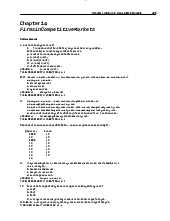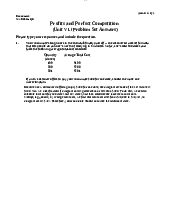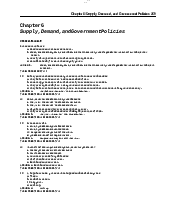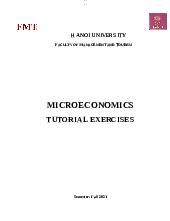





Preview text:
lOMoARcPSD|46342985 lOMoARcPSD|46342985
Tutorial 1: Introduction QUIZ
1. Economics is the study of A. production methods.
B. how society manages its scarce resources.
C. how households decide who performs which tasks.
D. the interaction of business and government.
2. A typical society strives to get the most it can from its scarce resources. At the same time, the society attempts
to distribute the benefits of those resources to the members of the society in a fair manner. In other words, the
society faces a tradeoff between A. guns and butter. B. efficiency and equality. C. inflation and unemployment. D. work and leisure.
3. The opportunity cost of an item is
A. the number of hours needed to earn money to buy the item.
B. what you give up to get that item.
C. usually less than the dollar value of the item.
D. the dollar value of the item.
4. Mallory decides to spend three hours working overtime rather than watching a video with her friends. She
earns $8 an hour. Her opportunity cost of working is
A. the $24 she earns working.
B. the $24 minus the enjoyment she would have received from watching the video. lOMoARcPSD|46342985
C. the enjoyment she would have received had she watched the video.
D. nothing, since she would have received less than $24 of enjoyment from the video.
5. For most students, the largest single cost of a college education is
A. the wages given up to attend school. B. tuition, fees, and books. C. room and boarD.
D. transportation, parking, and entertainment.
6. Suppose your management professor has been offered a corporate job with a 30 percent pay increase. He
has decided to take the joB. For him, the marginal
A. cost of leaving was greater than the marginal benefit.
B. benefit of leaving was greater than the marginal cost.
C. benefit of teaching was greater than the marginal cost.
D. All of the above are correct.
7. Senator Smart, who understands economic principles, is trying to convince workers in her district that
trade with other countries is beneficial. Senator Smart should argue that trade can be beneficial
A. only if it allows us to obtain things that we couldn't make for ourselves.
B. because it allows specialization, which increases total output.
C. to us if we can gain and the others involved in the trade lose.
D. in only a limited number of circumstances because others are typically self-interested.
8. A worker in Thailand can earn $2 per day making cotton cloth on a hand loom. A worker in the United States can
earn $80 per day making cotton cloth with a mechanical loom. What accounts for the difference in wages? lOMoARcPSD|46342985
A. U.S. textile workers belong to a union.
B. There is little demand for cotton cloth in Thailand and great demand in the U.S.
C. Labor is more productive making cotton cloth with a mechanical loom than with a hand loom.
D. Thailand has a low-wage policy to make its textile industry more competitive in world markets.
9. The adage, "There is no such thing as a free lunch," is used to illustrate the principle that A. goods are scarce. B. people face tradeoffs. C. income must be earneD.
D. households face many decisions.
10. The principle that "people face tradeoffs" applies to A. individuals. B. families. C. societies.
D. All of the above are correct.
11. Guns and butter are used to represent the classic societal tradeoff between spending on
A. durable and nondurable goods. B. imports and exports.
C. national defense and consumer goods.
D. law enforcement and agriculture.
12. High-school athletes who skip college to become professional athletes
A. obviously do not understand the value of a college education.
B. usually do so because they cannot get into college. lOMoARcPSD|46342985
C. understand that the opportunity cost of attending college is very high.
D. are not making a rational decision since the marginal benefits of
college outweigh the marginal costs of college for high-school athletes.
13. Russell spends an hour studying instead of playing tennis. The opportunity cost to him of studying is
A. the improvement in his grades from studying for the hour.
B. the improvement in his grades from studying minus the enjoyment of playing tennis.
C. the enjoyment and exercise he would have received had he played tennis.
D. zero. Since Russell chose to study rather than to play tennis, the value
of studying must have been greater than the value of playing tennis.
14. Rational people make decisions at the margin by
A. following marginal traditions.
B. behaving in a random fashion.
C. thinking in black-and-white terms.
D. comparing marginal costs and marginal benefits.
15. Tom is restoring a car and has already spent $3500 on the restoration. He expects to be able to sell the car for
$5000. Tom discovers that he needs to do an additional $2000 of work to make the table worth $5000 to
potential buyers. He could also sell the car now, without completing the additional work, for $2800. What should he do?
A. He should sell the car now for $2800.
B. He should keep the car since it wouldn’t be rational to spend $5500
restoring a car and then sell it for only $5000. lOMoARcPSD|46342985
C. He should complete the additional work and sell the car for $5000.
D. It does not matter which action he takes since the outcome will be the same either way.
16. Suppose that a country that has a high level of output per person agrees to trade with a country that has a
low level of output per person. Which country can benefit?
A. only the one with a low level of output per person.
B. only the one with a high level of output per person. C. both D. neither lOMoARcPSD|46342985 PROBLEMS
1. You win $100 in a basketball pool (a lottery). You have a choice between spending the money now or
putting it away for a year in a bank account that pays 5 percent interest. What is the opportunity cost
of spending the $100 now?
2. Imagine a society that produces military goods and consumer goods, which will call “guns” and “butter”.
a. Draw a production possibilities frontier for guns and butter. Explain why it most likely has a bowed-out shape.
b. Show a point that is impossible for the economy to achieve. Show a point that is feasible but inefficient.
c. Imagine that the society has two political parties, called the Hawks and the Doves. The Hawks want a
strong military, and therefore they want to produce a lot of guns and not much butter. The Doves want
a small military, and therefore want to produce less guns and more butter than Hawks. Show a point
on your production possibilities frontier that the Hawks might choose and a point that the Doves might choose.




